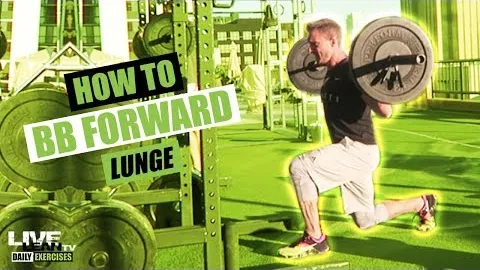
The barbell forward lunge is a compound exercise that targets the lower body muscles, specifically the glutes, quadriceps, and hamstrings. This exercise is highly effective for building strength, improving balance, and enhancing overall lower body function. By integrating the barbell into the forward lunge movement, it adds an extra level of challenge and engages the core muscles for stability. In this guide, we will provide a step-by-step breakdown of how to perform the barbell forward lunge exercise correctly and safely.
The barbell forward lunge offers numerous benefits to individuals seeking to improve their lower body strength and stability. Some of the key advantages of incorporating this exercise into your routine include:
Greater muscle activation: The barbell forward lunge targets multiple muscle groups simultaneously, leading to increased muscle activation and growth. This exercise primarily engages the glutes, quadriceps, and hamstrings, while also involving the core muscles for stability.
Improved balance and stability: By stepping forward with each lunge while holding a barbell, you challenge your balance and coordination. This exercise contributes to better overall stability, which is crucial for performing various activities and sports.
Functional strength development: The barbell forward lunge mimics everyday movements like stepping and lunging, making it a functional exercise. This type of strength training translates into improved performance in activities such as running, jumping, and squatting.
Core engagement: The barbell's added weight demands increased core activation to maintain stability throughout the movement. This engagement not only strengthens your abdominal muscles but also contributes to better posture.
Enhanced flexibility: Regularly performing barbell forward lunges can lead to improved hip and ankle flexibility over time. This increase in flexibility is essential for preventing injuries and maintaining joint health.
Follow the step-by-step instructions below to perform the barbell forward lunge exercise correctly:
Step 1: Start by placing a barbell across your upper back. Ensure that it is centered and secure on your traps, gripping the barbell with both hands.
Step 2: Stand with your feet shoulder-width apart, toes pointing forward. Maintaining an erect posture, engage your core muscles.
Step 3: Take a controlled step forward with your right foot, maintaining your balance and stability. The length of your stride will depend on your comfort level and mobility; however, a longer stride will intensify the exercise.
Step 4: Lower your body into a lunge position, ensuring that your right knee is directly above your ankle and your left knee is nearly touching the ground. Keep your weight evenly distributed between your front and back leg.
Step 5: Push through your right heel to raise your body back up into the starting position. Maintain control throughout the movement, focusing on using your legs rather than relying solely on momentum.
Step 6: Repeat the movement with your left leg, taking a step forward and performing a lunge. Remember to maintain proper form and control throughout.
While the barbell forward lunge is an effective exercise, it is important to prioritize safety and proper form. Consider the following tips to ensure a safe and effective workout:
Start with bodyweight: If you are new to this exercise or are unsure of your strength level, begin by performing the forward lunge without adding any external weight. This will allow you to familiarize yourself with the movement and gradually progress.
Choose an appropriate weight: Once you have mastered the bodyweight version, you can add a barbell to increase the intensity. Start with a weight that challenges you but still allows you to maintain proper form throughout the exercise. Gradually increase the weight as your strength improves.
Maintain proper form: Keeping your upper body upright and your core engaged is essential for preventing injuries. Avoid leaning too far forward or arching your back while performing the lunge. Focus on good posture and control throughout the movement.
Avoid locking your knees: As you push back up from the lunge position, be careful not to lock your knees fully. This can place unnecessary stress on the knee joint. Instead, keep a slight bend in your knee to maintain joint stability.
Listen to your body: Pay attention to any discomfort or pain during the exercise. If you experience sharp or persistent pain, stop immediately and consult with a healthcare professional.
Incorporating the barbell forward lunge into your lower body workout routine can greatly improve your overall strength, stability, and balance. This compound exercise targets multiple muscle groups while engaging the core for enhanced stability. By following the correct form and gradually increasing the weight, you can optimize the benefits of this exercise and prevent injuries. Remember to prioritize safety and listen to your body throughout your fitness journey. Start by mastering the bodyweight version before progressing to using a barbell. With dedication and consistency, the barbell forward lunge can help you achieve your fitness goals.
If you're looking for a gym, fitness club or yoga studio, you've come to the right place.
You can find information about gyms in your area. Browse catalog of gyms and find gyms with classes which are you looking for.
On gym page you can find simple information like address, phone or website. You can find list of available classes. You can check availability of personal training or small group classes. On place page you can also see information about open hours.
You can find gyms near you with amenities, courts, studios and equipments.
Use our map to find gym at your city or district.
In Gym Navigator you can find list of exercises with movies for many body parts.
You can browse exercises catalog and find exercises the best of you.
You can also find exercises grouped into workout plans, which you can use to improve you body. Each routine show you exercises one by one and give you possibility to count you progress and count down rest time.